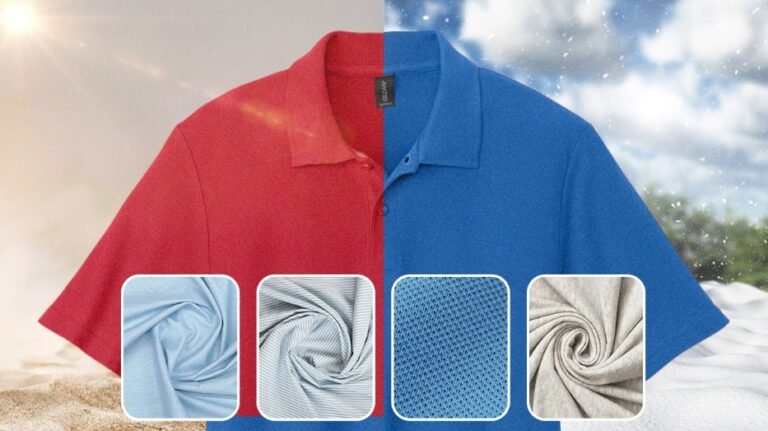Polo shirts have become so widely popular that their relevance transcends seasons. They function as great uniform components across America’s corporate landscape, educational institutions, and athletic teams with their versatility. It’s also this versatility that makes polo shirts relevant even when temperatures change. The versatility of polo shirts is attributed to the fabric material, which makes fabric selection an important factor to consider for year-round comfort in wearing polo shirts.
Wholesale blank polo shirt manufacturers like Core 365 and Sport-Tek have their own specialized blends and materials that deliver superb performance in addition to various features to suit changing temperatures. When purchasing uniform polo shirts, knowledge about fabric properties help a lot in ensuring wearers are satisfied, appearance standards are kept, and garments won’t need too many periodic replacements.
Cotton: The Quintessential Summer Fabric
The naturally superior breathability of cotton polos make them excellent in specific conditions. The fiber’s speciality is in absorbing moisture, though it also retains it. However, the cooling effect created by the material’s air circulation makes cotton a great pick during summer.
Its properties include:
- Excellent air permeability
- Progressive softening with repeated washing
- Hypoallergenic qualities for sensitive skin
- Biodegradable composition
Despite its merits, maintenance of standard cotton apparel does get challenging, with the likes of wrinkle formation and potential shrinkage after washing cycles. Premium varieties like Pima cotton feature longer fibers that resist pilling. Pima is also known for maintaining shape integrity longer than regular cotton.
Cotton performs best in moderate temperature ranges and primarily as a layering piece during extreme cold. With additional features, it can also be used, to an extent, during intense heat conditions.
Polyester: Technical Performance and Durability
Polyester can be a great year-round choice depending on the manufacturing. Modern polyester fabrics promise high-performance in addition to the features everyone expects from contemporary polyester. Polyester polo shirts can resist wrinkles effectively while maintaining dimensional stability. Many wash cycles won’t degrade the fabric significantly, unlike cotton.
Key advantages of modern polyester polos include:
- Rapid drying capability
- Superior colorfastness
- Exceptional durability
- Resistance to stretching and shape distortion
For example, many Core 365 polo styles utilize advanced polyester formulations engineered for specific environments. CornerStone, another wholesale apparel brand, offers polo workwear that will be useful in any season. Sport-Tek polo shirts are made for athletes and sports enthusiasts, and their properties could work well from Spring through Fall.
Polyester’s limitations primarily involve reduced breathability during extreme heat and potential odor retention if the garment lacks antimicrobial properties. Still, not all polyester polos have those issues.
Technological advancements have introduced moisture-wicking properties in polyester garments without retaining moisture, unlike cotton. Polos with antimicrobial finishes that substantially address odor problems are also available today.
Cotton-Polyester Blends: Year-Round Balanced Performance
Hybrid fabrics that combine cotton and polyester deliver optimized performance, offering the best of both materials. Fabric blends are season-agnostic generally, and work well throughout the year. Common blend ratios typically fall between 50/50 and 60/40 cotton-to-polyester distributions.
These composites offer:
- Moderate breathability from cotton content
- Enhanced durability from polyester components
- Improved wrinkle resistance
- Accelerated drying compared to 100% cotton options
- Additional features like UV protection, moisture-wicking, snag-resistance etc.
Blends are more resistant to shrinkage too, which makes them beneficial to organizations that require consistent sizing to outfit large teams. Additionally, polos made of fabric blends generally retain color better than cotton-only alternatives. As uniforms, these polos maintain appearance standards through extended periods regardless of the season.
For organizations operating with constrained uniform budgets, cotton-polyester blends deliver exceptional value due to their longevity and minimal replacement requirements.
Pique versus Jersey Performance Differences
The weaving technique significantly impacts polo shirt performance beyond basic material composition. Two such methods prevail in the marketplace: pique and jersey.
Pique fabric features:
- Textured waffle-pattern construction
- Integrated ventilation through structural air pockets
- Enhanced structural integrity
- Medium weight suitable for temperature transitions
Jersey fabric features:
- Smooth, uniform surface texture
- Maximum lightweight properties for extreme heat conditions
- Enhanced stretch characteristics
- Softer hand feel against skin surfaces
Both construction methods appear across various material compositions. Cotton pique delivers excellent performance in moderate temperature environments with controlled humidity, while polyester jersey is best suited for high-humidity conditions requiring rapid moisture evaporation.
Climate-Specific Material Selection Guidelines
It’s recommended to consider regional climate patterns when selecting appropriate polo fabrics.
For high-temperature, high-humidity regions:
- Polyester with enhanced moisture management
- Higher polyester percentage blends
- Jersey or Polyester Jersey
For cold, dry environmental conditions:
- Medium-weight cotton-poly blends
- Pique construction with thermal properties
- Pure cotton options for temperature-controlled settings
For variable climate regions:
- Balanced 50/50 cotton-polyester blends
- Fabric weights depending on warmth
- Fabrics and fabric blends with rapid-drying properties
Purchasing polo shirts in bigger volumes typically enable price concessions from apparel distributors. The market generally considers the cotton-polyester blend category to deliver optimal value when bought in bulk. This is due to the blend’s performance attributes against acquisition costs.
Selecting uniform polo shirt materials for any season requires an application, in some capacity, of practical fabric knowledge to organizational requirements. A uniform program should ideally match fabric characteristics to specific requirements, regional climate, and available budget parameters. This approach ensures appropriate comfort levels across seasons while maintaining professional appearance standards for organizations.
